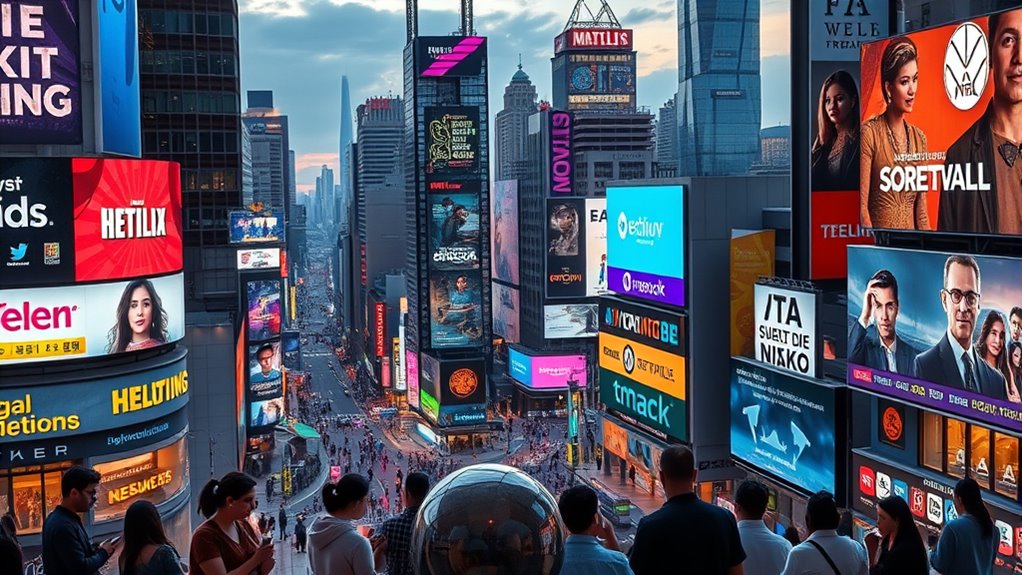You’re going to see five major tech trends shaping OTT in 2025. AI-driven content personalization will make recommendations spot-on. Streaming quality will leap with 4K and 8K content, thanks to better compression tech. Hybrid monetization models will cater to different viewer preferences, combining ads and subscriptions. Immersive AR and VR will elevate user engagement through unique experiences. Ultimately, global expansion will focus on localized content to reach diverse audiences. Discover more about these exciting transformations ahead.
Key Takeaways
- AI-driven content personalization will enhance media discovery, providing tailored recommendations based on real-time user behavior and preferences.
- Streaming quality will advance towards 4K and 8K standards, supported by improved compression algorithms and infrastructure upgrades for higher bandwidth.
- Hybrid monetization models will dominate, combining subscription, advertising, and transactional options to cater to diverse consumer preferences and combat subscription fatigue.
- Immersive experiences through AR and VR technologies will transform content engagement, enabling interactive storytelling and social viewing in virtual environments.
- Global expansion strategies will focus on local content and tailored user interfaces to cater to diverse markets and cultural preferences.
AI-Driven Content Personalization

In the world of OTT streaming, AI-driven content personalization is revolutionizing how you discover and engage with media. Using machine learning algorithms, platforms analyze your behavior, enhancing your content discovery experience. Real-time data means you get timely recommendations tailored to your interests. Imagine receiving personalized trailers that highlight elements you love, making it easier to choose what to watch. The future holds even more exciting possibilities, like context-aware suggestions based on your emotional state or location. As AI continuously refines its algorithms, expect increased watch time and reduced decision fatigue, ultimately boosting your overall satisfaction. Additionally, AI-generated smart trailers will focus on user interests, highlighting specific genres or elements that resonate with you. By embracing data-driven personalization, platforms can create more engaging user experiences that cater to individual preferences.
Enhanced Streaming Quality With 4K and 8K

As AI reshapes content personalization, the next leap in your viewing experience is enhanced streaming quality with 4K and 8K resolutions.
Currently, 4K streaming is the standard, requiring a bitrate of at least 20MB/s, while 8K is emerging, needing 60-90MB/s. Advances in compression algorithms like AV1 and VVC are essential for delivering high-quality content efficiently. As infrastructure upgrades become necessary to support these higher bandwidth demands, you can expect more seamless streaming. Ultra-low latency streaming is anticipated to become standard, particularly for live events, enhancing the overall viewing experience. Although 8K content and devices are still limited, industry initiatives are pushing for broader adoption.
The Rise of Hybrid Monetization Models

While the OTT landscape evolves, hybrid monetization models are gaining traction as a solution to meet diverse consumer needs.
These models combine subscription (SVOD), advertising (AVOD), and transactional (TVOD) options, maximizing revenue streams and catering to various preferences. By offering both ad-supported and ad-free content, they attract a broader audience and combat subscription fatigue. Additionally, understanding monetization strategies can optimize revenue generation and enhance user experience. Platforms like Hulu and Peacock exemplify this flexibility, allowing viewers to choose their ideal experience. Advanced technologies like server-side ad insertion and real-time analytics support these models, ensuring seamless ad delivery and performance tracking. Furthermore, the integration of AI across industries can help personalize content recommendations, enhancing user engagement.
As global subscriptions near 2 billion, hybrid monetization will help platforms differentiate themselves in an increasingly competitive market. Embracing these models is essential for future success.
Immersive Experiences Through AR and VR

Immersive experiences through augmented reality (AR) and virtual reality (VR) are transforming how you engage with content. These technologies let you step into your favorite shows, offering enhanced storytelling and interactive environments where you can explore characters and objects. With AR and VR, social viewing becomes a reality, allowing you to connect with friends and family in virtual spaces. The integration of these technologies with OTT platforms creates personalized engagement, driven by AI recommendations. Thanks to 5G, streaming quality improves, making immersive content more accessible. As the OTT market grows, expect diverse offerings—from movies to live sports—that leverage interactive storytelling for an engaging user experience unlike any other. Prepare for a future where your viewing habits evolve dramatically.
Global Expansion and Localization Strategies

The rise of immersive technologies like AR and VR is just one piece of the puzzle in the dynamic world of OTT. As the market climbs to an estimated $332.5 billion by 2025, global expansion and localization strategies are essential. You’ll see platforms like Netflix and Disney+ explore emerging markets in Asia, Latin America, and Africa, where internet access and smartphone use are booming. They’re focusing on local content, incorporating subtitles and dubbing in various languages, and tailoring user interfaces to enhance engagement. The growth of the OTT market reflects changing preferences in consumer behavior, prompting platforms to adapt and innovate. Pricing strategies will also shift to make services more affordable in these regions. Understanding cultural nuances and consumer preferences will be vital as OTT platforms navigate this rapidly evolving landscape.
Frequently Asked Questions
How Will AI Impact Content Creation in the Future?
AI’s going to revolutionize content creation for you.
It’ll automate tasks like idea generation and proofreading, boosting your efficiency. You’ll see quality improvement as AI analyzes audience data, helping you craft engaging content.
Personalization will enhance your connection with readers, while multilingual capabilities expand your global reach.
Plus, collaboration tools will streamline your workflow, making it easier to manage projects.
Embracing these advancements means you’ll stay ahead in the ever-evolving content landscape.
What Role Will 5G Play in Streaming Services?
Did you know that 5G can support up to a million devices per square kilometer? This incredible capability revolutionizes streaming services by enhancing video quality and reducing buffering.
You’ll experience smoother playback with higher resolutions, thanks to increased bandwidth and lower latency. Plus, 5G’s improved connectivity allows for more interactive content, making your streaming experience richer and more engaging.
It’s a game-changer, ensuring you enjoy uninterrupted, high-quality video anytime, anywhere.
How Can Viewers Influence Content Offerings on OTT Platforms?
You can influence content offerings on OTT platforms by engaging with personalized recommendations, providing real-time feedback, and actively participating in interactive features.
Your viewing habits shape what content gets produced, as platforms analyze your preferences and consumption patterns.
By voicing your opinions through ratings or social interactions, you help platforms understand what you want.
This power lets you steer the direction of content, making it more aligned with your interests and preferences.
What Are the Environmental Impacts of Streaming Services?
Streaming services have a significant environmental impact, contributing about 1% of global carbon emissions.
You mightn’t realize that high-resolution content, like 4K, drives up energy consumption. Data centers and network infrastructure play major roles in this, relying heavily on fossil fuels.
As demand grows, it’s essential to contemplate sustainable practices, like using renewable energy and encouraging lower-resolution streaming, to help mitigate these environmental effects and make a positive change.
How Will User Privacy Be Protected With Advanced Technologies?
Did you know that 79% of consumers are worried about how companies use their personal data?
To protect your privacy, advanced technologies like homomorphic encryption allow data processing without exposing sensitive information. AI-driven tools can detect breaches in real-time, while data clean rooms guarantee secure sharing.
Companies will also focus on transparency, giving you clear insights into how your data’s collected and used, building trust in an increasingly digital world.
Conclusion
As we approach 2025, staying ahead in the OTT landscape means embracing these tech trends. Did you know that by then, over 80% of consumers will expect personalized content tailored just for them? This shift in viewer expectations will push platforms to innovate continuously. By leveraging AI, enhancing streaming quality, and exploring new monetization strategies, you can guarantee your OTT service remains competitive and engaging. Get ready to adapt and thrive in this dynamic environment!









